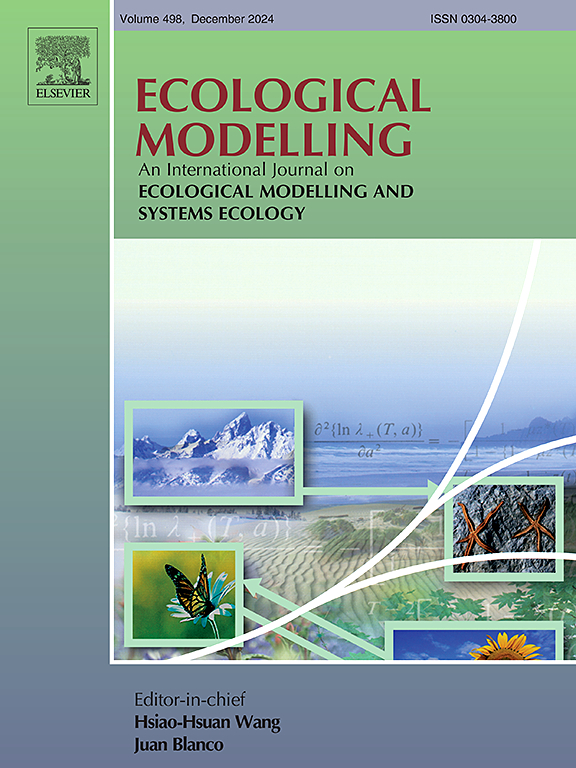精细尺度的表面复杂性促进了极端温度,但减少了海岸岩石上避难所的空间范围
IF 2.6
3区 环境科学与生态学
Q2 ECOLOGY
引用次数: 0
摘要
微生境的物理结构,特别是朝向太阳直接辐射的方向,可以从根本上影响个体生物的体温、生理性能和生存。本文采用有限元(FE)数值模拟方法模拟了潮间带岩石生境的时空温度变化,系统地探讨了基材粗糙度在极小生物(cm)尺度上驱动地表温度变化的作用。该方法考虑了细尺度(mm-cm)表面特征之间通过辐射、对流和传导进行的三维热交换。在以色列海法海岸的潮间带地点,使用地面激光扫描仪对地表进行了分析。模拟结果提供了与现场红外摄像机记录的温度相当的温度。通过数值生成一系列粗糙表面,探索表面粗糙度尺度与微生境温度之间的关系,以及这些关系在昼夜周期和季节之间的变化。总体而言,增加栖息地复杂性对1 ~ 1 m2表面的平均温度影响不大,尽管该表面内微栖息地之间的差异高达25°C。最热和最冷微生境的温度值随粗糙度的增加而显著增加,这通常支持“生境异质性假说”,即热微环境的范围预计会随表面粗糙度的增加而增加。在这里,我们将这种模式归因于观察到的凉爽、阴凉的“山谷”微栖息地的存在总是伴随着暴露在充分、直接的太阳辐射下的“峰”的存在。本文章由计算机程序翻译,如有差异,请以英文原文为准。
Fine-scale surface complexity promotes temperature extremes but reduces the spatial extent of refugia on coastal rocks
The physical structure of microhabitats, especially orientation to direct solar radiation, can radically influence the body temperatures of individual organisms, their physiological performance, and survival. Using a numerical approach via finite element (FE) analysis to simulate the spatial and temporal temperature variations in rocky intertidal habitats, we systematically explored the role of substrate roughness in driving variability of surface temperatures at scales relevant to very small (cm) organisms. This approach accounts for three-dimensional heat exchange among fine-scale (mm-cm) surface features through radiation, convection, and conduction. Analyses were performed for a surface mapped using a terrestrial laser scanner at an intertidal site on the coast of Haifa, Israel. Simulation results provided comparable temperatures to those recorded in the field via infrared camera. A series of rough surfaces were generated numerically to explore relationships between the scale of surface roughness and microhabitat temperatures, and how these relationships changed both over a diurnal cycle and across seasons. Overall, increasing habitat complexity had little influence on the average temperature of a ∼1 m2 surface, despite differences of up to 25 °C among microhabitats within that surface. Temperature magnitudes of the hottest and coolest microhabitats increased markedly with roughness, generally supporting the ‘habitat heterogeneity hypothesis’ where a range of thermal microenvironments is predicted to increase with surface roughness. Here, we attribute this pattern to the observation that the presence of cool, shaded “valley” microhabitats is invariably accompanied by the presence of “peaks” exposed to full, direct solar radiation.
求助全文
通过发布文献求助,成功后即可免费获取论文全文。
去求助
来源期刊

Ecological Modelling
环境科学-生态学
CiteScore
5.60
自引率
6.50%
发文量
259
审稿时长
69 days
期刊介绍:
The journal is concerned with the use of mathematical models and systems analysis for the description of ecological processes and for the sustainable management of resources. Human activity and well-being are dependent on and integrated with the functioning of ecosystems and the services they provide. We aim to understand these basic ecosystem functions using mathematical and conceptual modelling, systems analysis, thermodynamics, computer simulations, and ecological theory. This leads to a preference for process-based models embedded in theory with explicit causative agents as opposed to strictly statistical or correlative descriptions. These modelling methods can be applied to a wide spectrum of issues ranging from basic ecology to human ecology to socio-ecological systems. The journal welcomes research articles, short communications, review articles, letters to the editor, book reviews, and other communications. The journal also supports the activities of the [International Society of Ecological Modelling (ISEM)](http://www.isemna.org/).
 求助内容:
求助内容: 应助结果提醒方式:
应助结果提醒方式:


